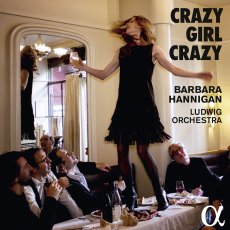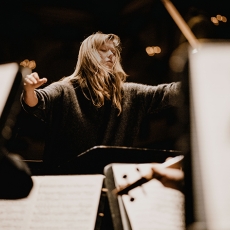Barbara Hannigan - Crazy Girl Crazy - Gramophone
One of music’s great risk-takers, Barbara Hannigan goes out on a limb with ‘Crazy Girl Crazy’, her debut album as both conductor and singer, in which she flanks the Lulu Suite with Berio’s unaccompanied Sequenza III and a suite from Gershwin’s Girl Crazy, arranged in tandem with the Broadway orchestrator Bill Elliott and scored for the same forces as the Berg. The accompanying art-house documentary, Music is Music, integral to the whole, is the work of actor-director Mathieu Amalric, whose road movie Tournée won him Best Director at Cannes in 2010.
In her booklet notes, Hannigan forges subjective and interpretative links between the three works. When she first sang Lulu her ‘perceptions of performance, love and death were changed’, she writes. The disc is ‘a hall of mirrors’ in which Sequenza III and Girl Crazy serve as ‘reflections of Lulu from varying angles and stages of her life’. Sequenza III, with its yearning for stability and space, is consequently emblematic of the teenage Lulu finding ‘her voice, her words and her place in the world’. ‘But not for me’, with which she opens the Girl Crazy suite, has links to ‘the lonely Geschwitz’, while ‘Embraceable you’, which follows, inhabits, she claims, comparable emotional territory to Lulu’s relationship with Alwa.
Irrespective of whether you agree with all this, the disc is uneven. Fine singer though Hannigan is, she seems less assured here as a conductor, and the Lulu Suite, in particular, proves problematic. The Ostinato and Variations have a certain gritty force but the outer movements lack drama despite speeds that are by no means inordinately slow. Her voice soars exquisitely in the Lied, though we could do with more of the words. Purists might jib at Hannigan’s reharmonisation of Gershwin, complete with note rows and Ligeti tone clusters, though her vocals are exuberant and the playing stylish. It’s Sequenza III, however, written for Berio’s muse Cathy Berberian, that is the high point. Transposed upwards it acquires both an unnerving vulnerability and a tentative optimism, where Berberian sounds world-weary and sad. It’s a beautiful performance.
Just as Hannigan conducts as she sings, so the members of the Ludwig Orchestra sing as they play, forming the Hollywood-style chorus that serenades her in ‘Embraceable you’. This only becomes apparent in Amalric’s film, which interweaves rehearsal footage with shots of the Nova Scotia landscape in which Hannigan grew up. Amalric intones the text – Hannigan’s own, at times close to her booklet notes – over a soundtrack that deliriously elides all three works, as phrases from Berio morph into Geschwitz’s final threnody and the Ludwig Orchestra sing ‘Embraceable you’ in extraordinary counterpoint over the Lulu Suite’s Adagio. Much of it is riskier than the disc and, in its idiosyncratic way, more consistently successful.

